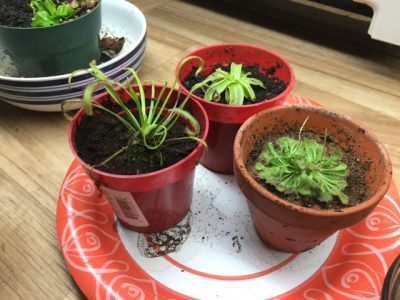Almost every time I go to Lowe’s I see Venus fly traps or pitcher plants for sale. Last week a colleague asked about mine–mainly how do I keep them alive? His son had convinced him to let him bring one home. Within weeks, the leaves were turning black, and no new leaves were forming. Unfortunately, other symptoms, such as rotting leaves, didn’t match those of a plant going into dormancy.
I have been raising carnivorous plants for a few years now so after trial, error, and lots of research, I have found that the mistakes I made with my first fly trap (R.I.P. Chompy) are common with lots of people who buy these unique plants. I currently grow fly traps, pitcher plants, sundews, and a butterwort under a 4 ft. long T5 light. I have found that the right water, soil, and lighting has made my savage garden successful.
Water
Ninety-five percent of the time, tap water will kill! I collect rain water or purchase distilled. The chemicals that are used to treat water can build up in the soil, harming the plant. Speaking of soil, one of the first things I learned in my research is that these plants do not grow in average house plant potting soil.
Soil
I have had success with 50/50 perlite and Sphagnum peat moss and–when I can get my hands on it–live sphagnum. These plants adapted to eat bugs to counter the lack of nutrients found in soils, so while this mix lacks the nutrients found in the potting soil, it is perfect for a savage garden to thrive in.
Light
In the summer I leave my plants outside whenever the low temperatures are above 55 degrees F to let them eat bugs and sun bathe. In the winter, some go into dormancy and others reside under a grow light. The long days here in the summer may cause a carnivorous plant to flower. I recommend cutting the flower off as soon as you see it. The plant puts all its energy into the flower and the remaining plant gets very little.

Feeding
I put my plants outside in the summer to let them feed on bugs naturally and then almost never feed in the winter. In the past I have had success with feeding crickets purchased at the pet store if the plant shows signs of needing nourishment such as no new growth and older growth dying off. It is safer to feed the plant bugs than to fertilize most often. Being such sensitive plants, over fertilizing can be deadly. The few times I have chosen to fertilize them, I used a highly diluted orchid fertilizer and so far this has been successful.

I enjoy raising these plants and chose to share these few things because I almost gave up on growing them after my first one died so quickly. I am glad I stuck with it–especially when I see pesky mosquito’s or gnats sneak in my house only to be consumed by my little savage garden. Hope this little bit of information helps anyone with or considering purchasing carnivorous plants
I used to own fly traps when I was a child, I’ve considered getting some recently. Does this information apply to all carnivorous plants? Do you have any specific tips for pitcher plants? I recently saw some in a hanging basket and was intrigued.
It does. I have found my flytraps are the most sensitive of all my plants. My pitcher plants (Nepenthes (has the pitchers coming off end of leaves); Sarracenia) are the easiest but also are my two largest plants and eat the most. There are highland and lowland pitcher plants. In Alaska, unless you have a greenhouse, I would recommend a highland or intermediate (crossbreed of high and low). Highlands can take cooler nights and don’t need as high a humidity. Good link to scroll through: https://www.growcarnivorousplants.com/Articles.asp?ID=266